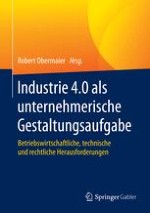
2016 | OriginalPaper | Chapter
Industrie 4.0 als unternehmerische Gestaltungsaufgabe: Strategische und operative Handlungsfelder für Industriebetriebe
Author : Prof. Dr. Robert Obermaier
Published in: Industrie 4.0 als unternehmerische Gestaltungsaufgabe
Publisher: Springer Fachmedien Wiesbaden
Activate our intelligent search to find suitable subject content or patents.
Select sections of text to find matching patents with Artificial Intelligence. powered by
Select sections of text to find additional relevant content using AI-assisted search. powered by